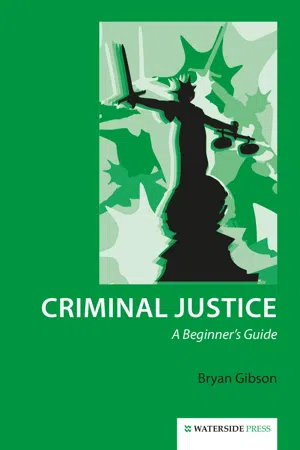
- English
- ePUB (mobile friendly)
- Available on iOS & Android
About This Book
The most straightforward overview available. Covers the entire criminal justice system. A 'no frills' explanation for beginners. This basic guide sets out the main components of the criminal justice system in an accessible way. Intended as a starting point for readers coming to the subject for the first time it is ideal for new staff, volunteers, first year students and other 'rookies': a short book of facts, explanations and pointers to further study.Chapters: 1. What is Crime?2. What is Criminal Justice?3. Who's Who?4. Modern Developments5. The Police6. The Criminal Courts in Action7. Sentencing (including Probation Work)8. Prisons and Imprisonment9. Victims and Restorative Justice10. Causes of CrimeThe book also features the Rule of Law, risk assessment, decision-making, forensic investigation, witnesses, surveillance, criminology, crime reduction strategies, border controls, penal reform and some international and historical dimensions.With a Glossary of Words, Phrases and Abbreviations.
Frequently asked questions
Information
1 What is Crime?
Crimes Change with the Times
- abortion, homosexuality, blasphemy (involving different deities), prostitution, adultery, hate crime, female genital mutilation and ‘mercy killing’ or ‘assisted dying’ are crimes in some countries (even today) but not in others
- controls of alcohol, drugs, tobacco or poisons have altered their legal status in different countries at different times, e.g. alcohol was outlawed in the USA during the prohibition era of the early 19th-century and is in some Muslim countries today (It was restricted in war-time Britain). Certain countries tolerate soft drugs whilst others periodically criminalise or re-classify existing drugs, or prohibit freshly invented ‘designer drugs’ or ‘legal highs’.
- certain countries allow people to carry weapons in a way that is wholly criminal in the UK and other states (the USA Constitution even contains a right to bear arms)
- UK anti-vagrancy laws proliferated in the early-1800s
- health and safety or similar regulations to protect workers are more likely to exist in developed countries
- cybercrime (Chapter 4) hardly existed ten years ago
- infanticide is an example of a crime created in Britain to mitigate the severity of the death penalty that would before 1965 have been visited on a mother for killing her own baby
- driving with excess alcohol in the blood has only existed as a crime in England and Wales since 1967 (though a difficult to prove offence of drunken-driving did exist); harassment since the 1970s; hate crime since around 2004; and some serious and thousands of lesser new criminal offences were created by New Labour from the late-1990s
- countries may have crimes peculiar to them, e.g. in Germany (and other countries) that of ‘denying the holocaust’
- polygamy is normal in some countries but bigamy (marrying whilst married) is an offence in most western states
- offences may spread from one country to another by emulation: a curious example is ‘smoking in a car when a child is present’, an offence in the USA and Canada and on the way to being one in Britain also; and
- the same behaviour may not be a crime in certain circumstances, e.g. killing in self-defence, war (within limits), or lawful execution which continues in many countries today.
Ingredients of Criminal Offences
Criminalisation and Decriminalisation
Moral panics and ‘new opportunities’ for crime
The Centrality of State Prosecutions and Sanctions
- whether the law prohibits given conduct, acts, failures, omissions, shortcomings, events or a given state of affairs
- if responsibility is placed on an individual or corporate body (when the latter is possible: corporations cannot think for themselves but sometimes a ‘controlling mind’ can)
- if the legal definition and ingredients of the offence fit exactly the conduct involved (this chapter, above)
- whether a given state of mind must be present (Chapter 2)
- whether there are any legally prescribed exceptions (such as picking wild flowers in the theft example above)
- whether the offence is treated as being against the crown (or state) as opposed to an individual victim; and
- whether there is provision for some kind of state-sponsored punishment once the offence is proved against the offender.
Sanctions
Who keeps the income from the CJS?
State prosecution and private prosecutions
- where a police warning is given on the street
- where a formal police cautions is issued at a police station by a senior police officer so long as the culprit admits the offence, i.e. a warning not to offend again or risk prosecution. Some cautions may have conditions attached. The CPS is ultimately responsible for advising whether a caution is appropriate (and there are different legal arrangements and standards concerning juvenile offenders)
- where administrative penalties are imposed...
Table of contents
- Copyright and Publication Details
- About the Author
- Introduction
- 1 What is Crime?
- 2 What is Criminal Justice?
- 3 Who’s Who?
- 4 Modern Developments
- 5 The Police
- 6 The Criminal Courts in Action
- 7 Sentencing
- 8 Prisons and Imprisonment
- 9 Victims and Restorative Justice
- 10 Causes of Crime
- Glossary of Words, Acronyms and Abbreviations
- Index